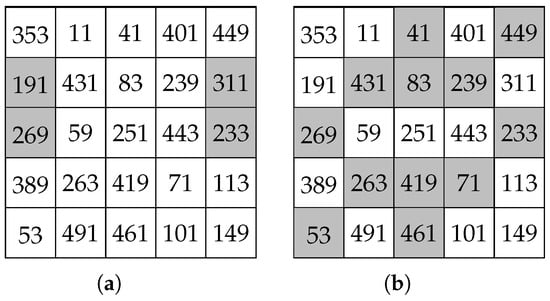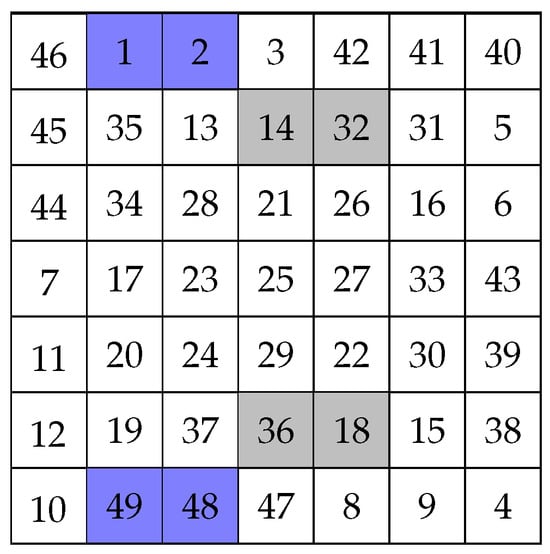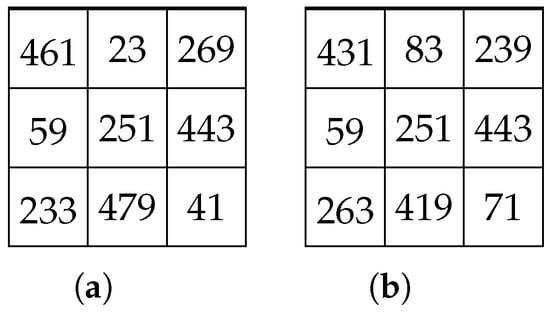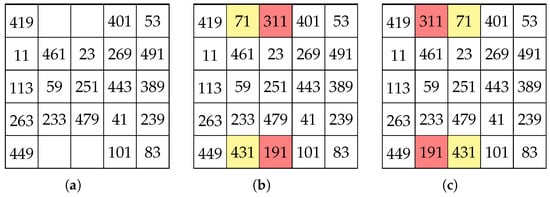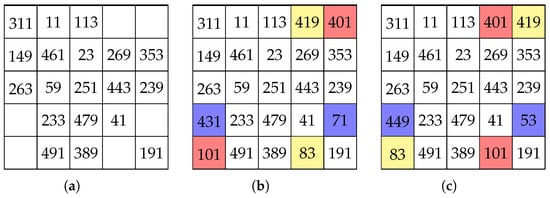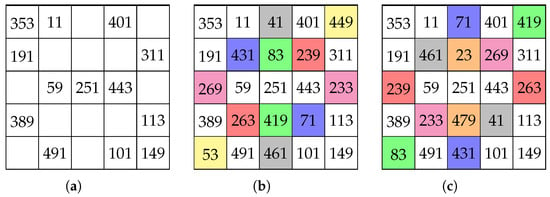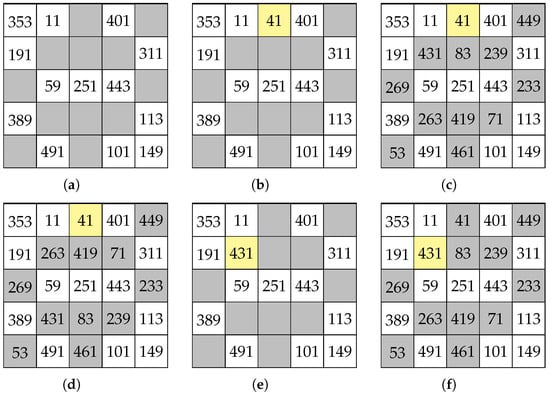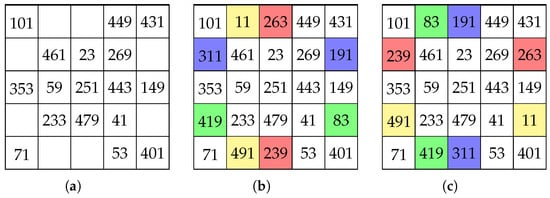Abstract
There has been much interest in the mathematical investigation of critical sets and unavoidable sets in Latin Squares, Sudoku, and their applications to practical problems in areas such as agriculture and cryptology. This paper considers the associated structures of Strictly Concentric Magic Squares (SCMSs) and Prime Strictly Concentric Magic Squares (PSCMSs). A framework of formal definitions is given that leads to the definitions of critical sets and unavoidable sets. Minimal critical sets are of interest in Latin Squares, and in this article, the cardinality of minimal critical sets of SCMS is given for all n, n odd. Two families of unavoidable sets are established for SCMS, leading to a complete classification of unavoidable sets of minimum PSCMS of order 5.
MSC:
05A99; 05B99
1. Introduction and Preliminaries
The study of completability of partial grids and their applications to areas such as experimental design, error-correcting codes, and computer science [,] is evident in the literature for Latin Squares and Sudoku. Keedwell [] briefly considered partial magic squares along with Latin Squares and Sudoku grids, investigating critical sets (sets comprising sufficient clues/information to ensure the unique completability) of normal magic squares of orders 3 and 4. Keedwell postulated that concentric magic squares may possess sufficient structure to enable the determination of critical sets within grids of a larger order. While a partial grid containing all values specified by a critical set ensures unique completion, unavoidable sets of a grid specify cell values that must be present in any critical set [,].
The current authors provided the first formal treatment of Strictly Concentric Magic Squares (SCMSs) in the literature [], presenting foundational material on, and terminology for, this structure, following from the literature on Latin Squares []. That paper presents a full enumeration of minimum Prime Strictly Concentric Magic Squares (PSCMSs) of order 5, which are squares composed entirely of prime numbers and having a minimum centre cell value. This paper extends this foundational material on SCMSs to critical sets and unavoidable sets, providing definitions and results on SCMSs in general, before applying these results to PSCMSs of order 5. A complete classification for unavoidable sets of minimum PSCMSs of order 5 is given.
The basic properties of magic squares that are needed in this paper are now given. A magic square of order n is an n-by-n grid containing distinct integers positioned such that all rows, columns, and main diagonals sum to the same value known as the magic constant. A normal magic square, NMS, contains the integers 1 to . A prime magic square, PMS, contains distinct primes. A cell of a grid of order n at row i, , and column j, , is denoted and has value . A triple specifies a value in row i and column j of a grid. Denote by the cells of a grid of order n, i.e., a set of tuples, and denote by a set of triples . A centre subsquare of order m, m odd, of a magic square of order n, n odd, comprises the centre m by m cells of the magic square, for , . The smallest such centre subsquare is of order 1. A magic centre subsquare of order m of a magic square of order n is a centre subsquare which is itself a magic square. The centre subsquare of order 1 is here considered a trivial magic centre subsquare, but otherwise the concept of concentric magic squares given here follows Andrews []. A magic square of order n, , for which its order centre subsquare is a magic centre subsquare is termed a concentric magic square, CMS.
This paper focuses on SCMS of order n, n odd, but where the definitions apply to both odd and even orders they are given in general. Throughout this paper it is taken that the centre cell value of the grid is always known and is denoted M.
Definition 1.
A magic square of order n, and odd, is strictly concentric, denoted an SCMS, if each of its order centre subsquares, , is a CMS. A centre subsquare of order 3 is here considered a trivial SCMS. A SCMS containing distinct primes is denoted a PSCMS.
In the exploration of completability of SCMS later in this paper, the concepts of borders and paired cells will be of importance due to constraints on the values in such cells. Definitions 2–6, and Table 1 below are taken from [].

Table 1.
Permutation operations on the border pairs in cells of an SCMS of order n, n odd, where the permutation order given is the smallest number of such permutations required to return to the initial state [].
Definition 2.
For an SCMS of order n, n odd, a cell has a paired cell , such that
Definition 2 is illustrated in Figure 1, in which the number in a cell relates to an equation number from Definition 2, and in combination with the following Greek letter indicates a pairing with another cell.
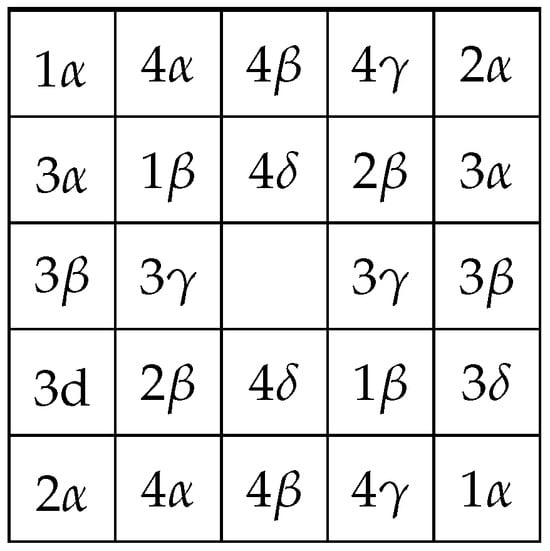
Figure 1.
Illustration of paired cells for an SCMS of order 5; the cell numbers relate to the equation numbers given in Definition 2, followed by a Greek letter denoting pairings.
Definition 3.
An SCMS of order n, n odd, and each of its centre subsquares has a border which comprises those cells which are adjacent to its respective outer edge. Let be the set of border cells of the SCMS of order n, and let be the set of border cells of its centre subsquares of order , . Let , .
That is, denotes the set of all the cells of an SCMS of order n, n odd, apart from the trivial centre subsquare.
Definition 4.
A border pair is a pair of values placed in cells in for an SCMS of order n, n odd, where and are paired cells.
An SCMS of order n, n odd, with centre cell value M has magic constant . It follows that the elements of each border pair of an SCMS of order n, n odd, sum to [].
Definition 5.
Denote two values summing to , where M is the centre cell value of an SCMS, as a pair of complement values. Hence, all border pairs of an SCMS are pairs of complement values. Denote two primes summing to , where M is the centre cell value of a PSCMS, as a pair of complement primes. Hence, all border pairs of a PSCMS are pairs of complement values (primes).
Definition 6.
An SCMS of order n, n odd, that has minimum centre cell value, M, is termed a minimum SCMS. A PSCMS of order n, n odd, that has minimum centre cell prime, M, is termed a minimum PSCMS.
The main focus of this paper is PSCMSs of order 5. All examples of SCMSs of order 5 given in this paper are minimum PSCMSs, and all examples of SCMS of order 3 are of valid centre subsquares of minimum PSCMSs of order 5. The magic constant of a minimum PSCMS of order 5, which has , is given in [] and the number of minimum PSCMSs of order 5 is enumerated in [].
The specific permutation operations in Table 1 (first given by the authors in []) may be performed on the outer border of the grid of order n and on the borders of its centre subsquares. Let s denote the order of the grid or its centre subsquares, , s odd. When applying the permutation operations to the border of the grid or a centre subsquare of order s, consider the rows and columns of the border to be numbered . Note that the first two permutation operations may not be performed on the centre subsquare of order 3, since there is only a single non-corner border pair, in each case [].
Definition 7.
Two Strictly Concentric Magic Squares, and , of order n with magic constant , n odd, are equivalent if one can be obtained from the other by undergoing specific permutations, given in Table 1. Otherwise the magic squares are non-equivalent.
All of the operations in Table 1 are feasible and each forms a group; further details can be found in [].
Let be a subset of the set of natural numbers . There exist pairs of complement values such that , where M is the centre cell value of an SCMS of order n, n odd, and are the values in paired cells. Likewise, this property holds for pairs of complement primes , where is a subset of the set of prime numbers and their sum is the centre cell value of a PSCMS of order n, n odd.
Firstly, in this paper, definitions are given for SCMSs, and secondly for PSCMSs, in relation to the completability of partial grids. Recall that the centre cell value, M, of the SCMS is known for a given grid; the pairs of values summing to form the corresponding set . The larger the chosen value of M, the more combinations of values summing to 2M there will be, and hence, the number of combinations of values summing to grows, and thus the cardinality of the set of values in is larger. It is noted that as is used to fill the remaining cells in the SCMS, then M must be chosen to be suitably large in order for there to be sufficient values for the given grid. Likewise, this holds for and the filling of cells in PSCMS. Given the value M, the set (or ) is easily determined.
These definitions are used in Section 2 to explore properties of partial SCMSs relating to their completability, and for the identification of critical sets in Section 3. Section 4 provides definitions for unavoidable sets of SCMSs, and Section 5 establishes two families of unavoidable sets for SCMSs, and provides a complete classification for unavoidable sets of minimum PSCMSs of order 5. The paper concludes by providing open problems in this area.
2. Completability of Partial SCMS with Non-Empty Centre Cell
In this paper, the term partial SCMS denotes a partial grid with a non-empty centre cell, as given in Definition 8.
Definition 8.
A grid of order n is termed partial if between 1 and cells are non-empty, including the centre cell. The set of tuples of the non-empty cells is denoted . When the non-empty cells have values such that the partial grid is completable to an SCMS then the set of triples is denoted and termed a partial SCMS.
An example of a partial PSCMS of order 3 is given in Figure 2a.

Figure 2.
A partial PSCMS of order 3 which is multiply completable and its two equivalent completions. (a) Two non-empty cells in a grid of order 3; (b) first completion of (a); (c) second completion of (a).
Definition 9.
Let be the set of all SCMSs to which can be completed. Hence, if then is uniquely completable, and if then is multiply completable.
Only partial grids which are partial SCMSs, , are considered in this paper; i.e., the partial grid is completable to an SCMS. Operations can be defined for assigning values, , to empty cells. The terms strongly and weakly completable are used in a manner similar to the established definitions in the literature for related combinatorial structures [].
Definition 10.
A cell of a partial SCMS, , is row-completable (or column-completable) if cells are non-empty in the given row (or column). A cell is pairwise-completable if its paired cell is non-empty.
Definition 11.
An empty cell in a partial SCMS, , that can be filled uniquely using a row/column/pairwise completable operation is referred to as forced.
Definition 12.
A completable partial SCMS, , is termed a strong partial SCMS, , if every empty cell becomes forced at some iteration of completion; otherwise, it is a weak partial SCMS, .
Lemma 1.
A strong partial SCMS, , is uniquely completable. A weak partial SCMS, , is either uniquely or multiply completable.
Proof.
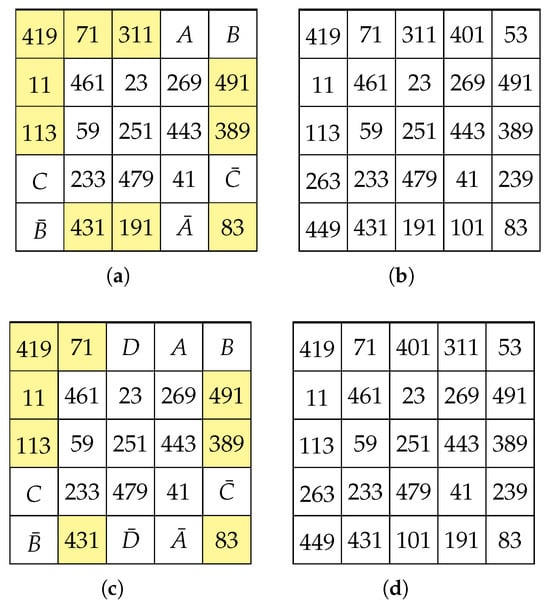
From Definition 12, all empty cells in a strong partial SCMS, , are forced; hence, there is only one way to complete the grid. A weak partial SCMS, , has at least one cell which is not forced. For specific partial SCMSs, one or more given cells that are not forced can be completed in more than one way (one such example is given in Figure 3c). For other specific partial SCMSs with one or more given cells that are not forced, all such cells are completable in only one way (one such example is give in Figure 3a). □

Figure 3.
Two weak partial PSCMS, , with non-empty border cells highlighted, and two completions. (a) A weak partial PSCMS, , which is uniquely completable; (b) unique completion of the partial PSCMS given in (a) and one completion of the partial PSCMS given in (c); (c) a weak partial PSCMS, , which is multiply completable; (d) second completion of the partial PSCMS given in (c), equivalent to (b).
Recall that grids of order 3 are here considered trivial SCMSs. Attention will be given first to SCMSs of order 3 before considering SCMSs of order 5 and of odd order .
Lemma 2.
A partial SCMS of order 3, , with two non-empty, non-paired cells in the border, , including at least one corner cell, is strongly completable and hence uniquely completable.
Proof.
Without loss of generality, assume the partial SCMS includes and one other non-paired triple, , in addition to the centre cell triple .
If (or ), then the third cell in the row (or column) is forced completable and the row (or column) is completed, and hence for are pairwise completable (or likewise for for ). The remaining two cells are forced.
If and , then the paired cell of is in either row 1 or column 1 and forced. Hence, the above argument applies. Hence, the grid is strongly completable and from Lemma 1 is uniquely completable. □
Corollary 1.
A partial SCMS of order 3, , with two non-empty non-paired cells in the border, , neither of which is a corner cell, is weakly and uniquely completable.
Proof.
The paired cells of the two non-empty cells in the border are forced, leaving just the corner cells empty. When all corner cells are empty, no cell is forced, so the grid is not strongly completable. However, there is only one way of completing the four corners to satisfy the magic constant constraint of a magic square. □
Lemma 3.
A partial SCMS of order 3, , with fewer than two non-empty cells in the border, , is weakly completable and multiply completable.
Proof.
Consider the case of a single non-empty corner cell, in addition to the centre cell. Without loss of generality, assume the partial SCMS includes ; hence, is pairwise completable and no other cell is immediately forced. There exist such that and are not paired, and such that , are not paired and . As , then, another completion of the partial SCMS exists in which both the paired values in positions and are permuted, and the non-paired values in positions and are permuted. Hence there are at least two completions, and therefore the SCMS is multiply completable.
Consider the case of a single non-empty, non-corner cell, in addition to the centre cell. Without loss of generality, assume the partial SCMS includes ; hence, is pairwise completable and no other cell is immediately forced. There exist three values in summing to , with their complement values also summing to 3M, in order to form the first column and the third column, such that the column and row sums are satisfied. Each of these can be placed in either the first or the third column, and hence there are always at least two completions and therefore the SCMS is multiply completable.
With all cells empty, other than the centre cell, there are no fewer completions than in the cases above. □
Lemma 3 is illustrated for in Figure 2, with a partial PSCMS of order 3, which is multiply completable, as shown in Figure 2a and its two equivalent completions shown in Figure 2b,c.
Corollary 2.
For a partial SCMS of order 3 to be strongly completable, it must contain at least two non-empty, non-paired cells, including at least one corner cell in addition to the centre cell.
Proof.
Follows directly from Lemmas 2 and 3 and Corollary 1. □
From Lemma 1, a weak partial SCMS, , is either uniquely or multiply completable, and an example of each case is given in Example 1 for with .
Example 1.
Figure 3a,c each show a partial PSCMS, , with and a non-empty centre subsquare of order 3. In Figure 3a the triples , , , , and their complement pairs are non-empty and highlighted. The empty cells A, B, C and their complements have only one completion, which is given in Figure 3b. In Figure 3c the triples , , , and their complement pairs are non-empty and highlighted. The empty cells A, B, C, D and their complements have two possible completions, given in Figure 3b,d.
Theorem 1.
For any partial SCMS, , of order n, n odd,
- 1.
- If is a strong partial SCMS, then it is uniquely completable.
- 2.
- If is multiply completable, then it is a weak partial SCMS.
- 3.
- If is a weak partial SCMS, then it is either uniquely completable or multiply completable.
- 4.
- If is uniquely completable, then it is either a strong or a weak partial SCMS.
Proof.
1. This follows immediately from Lemma 1.
- 2.
- If a grid is multiply completable, then it cannot be a strong partial SCMS, so it is a weak partial SCMS.
- 3.
- This follows immediately from Lemma 1.
- 4.
- From conditions 1 and 3, both strong and weak partial SCMSs can be uniquely completable.
□
3. Strong Partial SCMSs and Critical Sets of Partial SCMSs
Recall that is the set of cells of a strong partial SCMS and that is the set of triples of that strong partial SCMS.
Definition 13.
A minimal strong partial SCMS of order n, denoted , is a strong partial SCMS of minimum cardinality.
There may be more than one minimal strong partial SCMS that completes to a given grid . Two examples of minimal strong partial SCMSs are given in Figure 4a,b which are both uniquely completable to the grid in Figure 4c. The cardinality of the minimal strong partial SCMS, , is shown in Theorem 3.

Figure 4.
Two minimal strong partial PSCMSs, , and their unique completion, . (a) First minimal strong partial PSCMS ; (b) second minimal strong partial PSCMS ; (c) unique completion of the minimal strong partial PSCMS in (a,b).
The definition of a critical set in a Latin Square is given in [] and a similar definition is given here for critical sets of SCMSs.
Definition 14.
A critical set, , of an SCMS, , of order n, is a set such that
- 1.
- is the only SCMS of order n which has entry in position for all ;
- 2.
- No proper subset of satisfies (1).
Definition 14 can be re-expressed as Definition 15.
Definition 15.
A critical set is a partial SCMS that is uniquely completable to an SCMS , i.e., , and is such that if any triple is removed from , the resulting partial SCMS is multiply completable; i.e., for any , .
Definition 16.
A critical set, , is termed a strong critical set if it is also a strong partial SCMS, ; else it is a weak critical set.
Definition 17.
A minimal critical set of an SCMS of order n, denoted as , is a critical set of minimum cardinality.
Let denote the set of cells of a critical set, , and let be the set of all critical sets of . Consider such that , , and hence is a minimal critical set of . There may be more than one minimal critical set of a given SCMS.
Remark 1 follows immediately from Definition 14, using strong completability or weak completability.
Remark 1.
A critical set, , describes a partial SCMS, , which is uniquely completable.
A comparison of the cardinality of the minimal strong partial SCMS, , and the cardinality of the minimal critical set, , of an SCMS of order n, n odd, are now given, and the cardinality of the minimal strong partial SCMS of order n, n odd, is then calculated. Bounds are given for the cardinality of a minimal critical set of an SCMS of order n, n odd.
Lemma 4.
.
Proof.
Every strong partial SCMS is either a critical set or contains a critical set. □
Theorem 2.
A minimal strong partial SCMS of order n has non-empty cells in the border of each square of order j, , and in each of these borders, there is at most one cell of any non-empty border pair and at least one non-empty corner cell.
Proof.
Recall that the centre cell is non-empty.
Suppose that for each border of a partial SCMS, all corner cells are empty, and suppose that all non-corner cells in one row and one column of each border are non-empty. Then, each border of order j contains non-empty cells. All empty non-corner cells are pairwise completable, but the corner cells are not forced. Such a grid is not a strong partial SCMS.
Suppose that for each border of a partial SCMS, one corner cell is non-empty, and suppose that non-corner, non-paired cells are non-empty. By Definition 11, empty cells of each border are forced, but two pairs are not forced, and these are non-corner cells. From the permutation operations, Table 1, these are not uniquely completable.
Lastly, suppose that for each border of a partial SCMS, one corner cell is non-empty, and suppose that non-corner, non-paired cells are non-empty. By Definition 11, all non-empty cells of each border are forced. □
Corollary 3.
If an SCMS of order n, n odd, exists, then where .
Proof.
The proof follows immediately from Theorem 2. □
It is noted that , n odd, follows the integer sequence A058331 [], .
Theorem 3.
If an SCMS of order n, n odd, exists, then .
Proof.
From Theorem 2, for j odd, where , the size of the set of non-empty cells in the outer border or the order j grid, , is . Hence, . Since the centre cell is not included in a border but is always non-empty, then and hence . □
Theorem 4.
Given an SCMS of order n, n odd, , the size of the minimal critical set, , satisfies .
Proof.
First consider the upper bound of the size of the minimal critical set, from Lemma 4 and from Theorem 3 .
Now consider an SCMS of order 3; from Lemma 2 and Corollary 1 there are two non-empty cells in the border for the grid to be uniquely completable. Hence, a critical set contains no fewer than two triples, and with the inclusion of the centre cell value contains three triples. When , and hence there are exactly three non-empty cells for the minimal critical set, .
For j odd, where , the borders of order j of the centre subsquares and the outer border () of the SCMS of order n each have cells. For an SCMS of order n, , non-empty cells are required in each border for the SCMS to be uniquely completable; else it is multiply completable due to the permutation operations in Table 1. Hence, . Hence, , giving .
The centre subsquare of order 3 has three non-empty cells, and hence , and thus . □
Construction 1.
Take an empty grid of order 3 and fill in the centre cell to form a valid partial SCMS. Secondly, place one value in a corner to form a valid partial SCMS. Thirdly, place a further value in any cell that is not paired with that of the previously placed value to form a valid partial SCMS.
Theorem 5.
A strong partial SCMS of order 3 that is also a minimal critical set is specified by a partial grid obtained by Construction 1.
Proof.
Using Construction 1, the number of non-empty cells is 3, which satisfies , which is both the size of the minimal strong partial SCMS and the upper bound of the size of the minimal critical set. If either of the values in the border are removed, then the resulting grid is multiply completable, and hence the remaining triples do not form a critical set nor a strong partial SCMS. □
Without loss of generality, let the two non-empty cells of a partial SCMS of order 3, specified in Construction 1, be the cells and illustrated using a PSCMS in Figure 5a with its completion given in Figure 5b. Hence, , which satisfies the upper bound of Theorem 4.
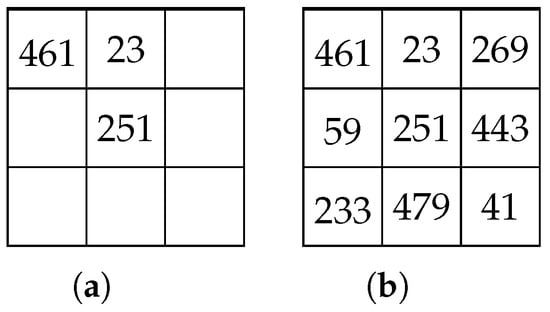
Figure 5.
A partial PSCMS, , specified by a minimal critical set, and its unique completion, . (a) Three non-empty cells in a grid of order 3; (b) unique completion of (a).
All critical sets of different sizes in Latin Squares of order at most 6, with their cardinality, are given in []. The cardinality of all minimal critical sets, , of an SCMS of order n, n odd, with known M and hence known , can be determined. For illustration, the SCMSs of order 5 (which are also minimum PSCMSs) have been taken from [], and the cardinality of their minimal critical sets is given.
Theorem 6.
The cardinality of all minimal critical sets of an SCMS of order 5 is , which satisfies , the lower bound of Theorem 4.
Proof.
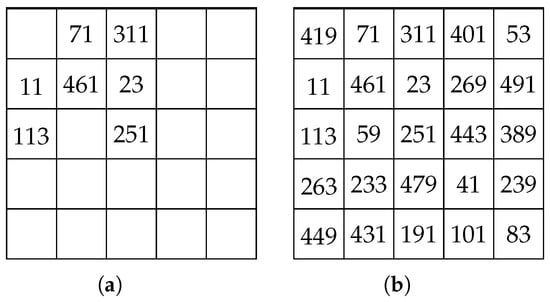
Suppose for contradiction there are six non-empty cells, including the centre cell. Given any SCMS, suppose there are six non-empty cells, including the centre cell. It can be clearly seen using the permutation operations in Table 1 that, irrespective of which cells are non-empty, the grid is multiply completable, and hence the non-empty cells do not form a critical set. An example of a critical set of size 7 of an SCMS of order 5 (which is also a minimum PSCMS) is given in Figure 6, and hence the cardinality of the minimal critical set of an SCMS of order 5 is 7. □

Figure 6.
A partial SCMS (which is also a minimum PSCMS), , specified by a minimal critical set, , of an SCMS and its unique completion, . (a) A grid specified by a minimal critical set of an SCMS of order 5; (b) unique completion of the partial SCMS in (a).
Theorem 6 will be useful for the classification of unavoidable sets of PSCMS of order 5 in Section 5.
While the concepts of strong and weak critical sets are extended above from the literature on Latin Squares to SCMS, a further concept of ‘totally weak’ critical sets [] (where no cell is initially forced) does not apply. Consider an SCMS with a valid centre cell value, the completion of any single cell results in a forced cell completion by a pairwise-completion operation. A set containing only the centre cell is not a critical set as the partial grid so defined is not uniquely completable. If both values in paired cells are non-empty and the grid is uniquely completable, then one of the values can be removed and the grid is still uniquely completable, and so the filled cells do not form a critical set. Hence, the concept of a totally weak critical set does not exist for any SCMS.
6. Conclusions
This paper provides foundational and theoretical underpinnings for SCMSs and PSCMSs. The concepts of critical sets and unavoidable sets previously defined for Latin Squares and Sudoku are defined for SCMSs, and two families of unavoidable sets of SCMSs are established. A full classification is given for unavoidable sets of minimum PSCMSs of order 5.
The definitions and results offer much scope for further work in this area. It remains an open problem whether there exist SCMSs with minimal critical set cardinality of 7 which are not also minimum PSCMSs. Another open problem is to determine how many unavoidable sets of different sizes exist on PSCMSs of higher orders. One trivial result is provided by Lemma 13.
Lemma 13.
If the empty cells of a partial PSCMS, , are an unavoidable set of Form 1, , then .
Proof.
Consider first a partial PSCMS with fewer than four empty cells; it is uniquely completable. Next consider a partial PSCMS with exactly four empty cells: the addition of any triple determines a unique completion. Finally, consider a partial PSCMS with more than four empty cells; the addition of a triple does not guarantee a uniquely completable grid. □
Similar to puzzles being constructed from Sudoku and Latin Square grids, puzzles may be constructed from SCMSs and PSCMSs, utilising their strong structural features and knowledge of their unavoidable sets to minimise the number of clues (filled cells) provided []. Applications of completable partial grids in Latin Squares and Sudoku to codes, cryptography and experimental design are well established in the literature [,,]. Recently, applications of magic squares to cryptography, have also been identified as being of interest [], and the current authors intend that the foundational material provided in this paper both enable and encourage further work in applications of SCMSs and PSCMSs.
Author Contributions
Conceptualization, S.P. and P.A.R.; methodology, A.L.S., S.P. and P.A.R.; validation, S.P. and P.A.R.; formal analysis, A.L.S., S.P. and P.A.R.; investigation, A.L.S.; writing—original draft preparation, A.L.S.; writing—review and editing, S.P. and P.A.R.; visualization, A.L.S., S.P. and P.A.R.; supervision, S.P. and P.A.R.; project administration, S.P. and P.A.R. All authors have read and agreed to the published version of the manuscript.
Funding
This research received no external funding.
Data Availability Statement
Data is contained within the article.
Conflicts of Interest
The authors declare no conflicts of interest.
Abbreviations
The following abbreviations are used in this manuscript:
| NMS | Normal Magic Square |
| CMS | Concentric Magic Square |
| SCMS | Strictly Concentric Magic Square |
| PSCMS | Prime Strictly Concentric Magic Square |
References
- Johnson, L.; Perkins, S. A discussion of a cryptographical scheme based in F-critical sets of a Latin square. Mathematics 2021, 9, 285. [Google Scholar] [CrossRef]
- Kuhl, J.; Denley, T. Constrained completion of partial latin squares. Discret. Math. 2012, 312, 1251–1256. [Google Scholar] [CrossRef]
- Keedwell, A.D. Defining sets for magic squares. Math. Gaz. 2006, 90, 417–424. [Google Scholar] [CrossRef]
- Williams, D.J.; Jones, S.K.; Roach, P.A.; Perkins, S. Blocking Intercalates In Sudoku Erasure Correcting Codes. IAENG Int. J. Comput. Sci. 2011, 38, 183–191. [Google Scholar]
- McGuire, G.; Tugerman, B.; Civario, G. There Is No 16-Clue Sudoku: Solving the Sudoku Minimum Number of Clues Problem via Hitting Set Enumeration. Exp. Math. 2014, 23, 190–217. [Google Scholar] [CrossRef]
- Skelt, A.L.; Perkins, S.; Roach, P.A. Prime Strictly Concentric Magic Squares of Odd Order. Mathematics 2025, 13, 1261. [Google Scholar] [CrossRef]
- Keedwell, A.D. Two remarks about sudoku squares. Math. Gaz. 2006, 90, 425–430. [Google Scholar] [CrossRef]
- Andrews, W.S. Magic Squares and Cubes, 2nd ed.; Dover: New York, NY, USA, 1960. [Google Scholar]
- Makarova, N. Concentric Magic Squares of Primes. Primes Magic Games. Available online: http://primesmagicgames.altervista.org/wp/forums/topic/concentric-magic-squares-of-primes/ (accessed on 24 January 2025).
- Keedwell, A.D.; Denes, J. Latin Squares and Their Applications; Elsevier: Amsterdam, The Netherlands, 2015. [Google Scholar]
- Cooper, J.; Donovan, D.; Seberry, J. Latin squares and critical sets of minimal size. Australas. J. Comb. 1991, 4, 113–120. [Google Scholar]
- Friedman, E. A058331. The Online Encyclopedia of Integer Sequences. Available online: https://oeis.org/A058331 (accessed on 15 April 2025).
- Adams, P.; Bean, R.; Khodar, A. A Census of Critical Sets in the Latin Squares of Order at Most Six. Ars Comb. 2003, 68, 203–223. [Google Scholar]
- Cutler, J.; Öhman, L. Latin Sqaures with Forbidden Entries. Electron. J. Comb. 2006, 13, R47. [Google Scholar] [CrossRef] [PubMed]
- Andrews, W.S. Magic squares (conclusion). Monist 1905, 15, 555–586. [Google Scholar] [CrossRef]
- Skelt, A.L.; Perkins, S.; Roach, P.A. Strictly Concentric Magic Square Puzzles. Math. Today 2022, 58, 84–86. [Google Scholar]
- Stones, R.J. K-Ples 2-Erasure Codes and Blackburn Partial Latin Squares. IEEE Trans. Inf. Theory 2020, 66, 3704–3713. [Google Scholar] [CrossRef]
- Zolfaghari, B.; Bibak, K. Combinatorial Cryptography and Latin Squares. In Perfect Secrecy in IoT; Springer: Cham, Switzerland, 2022; pp. 37–55. [Google Scholar]
- Singh, M. Latin Squares: Mathematical Significance and Diverse Applications. Res. Rev. J. Stat. Math. Sci. 2023, 9, 24–26. [Google Scholar]
- Rani, N.; Mishra, V. Application of Magic Squares in Cryptography. In Proceedings in Adaptation, Learning and Optimization, Proceedings of the International Conference on Intelligent Vision and Computing (ICIVC 2021), Online, 3–4 October 2021; Sharma, H., Vyas, V.K., Pandey, R.K., Prasad, M., Eds.; Springer: Cham, Switzerland, 2022; Volume 15. [Google Scholar] [CrossRef]
Disclaimer/Publisher’s Note: The statements, opinions and data contained in all publications are solely those of the individual author(s) and contributor(s) and not of MDPI and/or the editor(s). MDPI and/or the editor(s) disclaim responsibility for any injury to people or property resulting from any ideas, methods, instructions or products referred to in the content. |
© 2025 by the authors. Licensee MDPI, Basel, Switzerland. This article is an open access article distributed under the terms and conditions of the Creative Commons Attribution (CC BY) license (https://creativecommons.org/licenses/by/4.0/).
